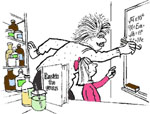Order Book or Supplements
Back to Top


This page reflects interesting physics tidbits, and it's our chance to show off our stuff. These details are not discussed in The Science of the Baseball Swing book because that book is written for coaches and players - - who want and need only the bottom line information. However, these details are indeed covered in the full-version book The Physics of the Baseball Swing, which is a bound copy of our 10 Technical Supplements.
From a physics standpoint, your power is all about storing energy in your bat, and you do this all the way through your swing right up to, and often through, contact.
Energy is stored in your bat, with the help of the three big muscle groups, as they constrict. Contrary to some beliefs, you do not transfer energy from any moving body parts to the bat. (There is one minor exception, which amounts to 5% of your power.) According to Robert Adair in "The Physics of Baseball" (3rd edition, 2002, p34), your body gets motion from the initial stride, and this forward moving body-energy somehow magically gets put into the bat. This is incorrect. If the bat gets any energy from the stride, it’s via contributing to the initital torso rpm speed. This is our polite way of saying that the bat gets no energy from your stride.
The stride is indeed critical to your swing, but for other reasons. This is one of many important new paradigms you will learn.
****************************************************************************************************************************************************************************
Why Bat Speed is not Always a Good Measure of your Power
Most of you have seen the article "Hitting a Baseball: A Biomechanical Description Aritcle", which provides experimental measurements of the swing. Their torso rotational rates (714º/sec and 937º/sec) are often quoted.
Read further and it states that the bat speed decreased by about 4 mph just before contact. What's that all about.
We quote that here: 350 px.jpg)
"The bat was then driven to its maximum linear velocity of 31 m/sec (69.3 mph)...…. occurring 0.015 seconds before ball contact. At ball contact…..The linear speed of the bat had de-accelerated slightly to 29 m/sec (64.8 mph)….. ....[Wech, C.M., Hitting a Baseball: A Biomechanical Descriptioin, JOSP V22 No 5 193-201 November 1995.]
The article did not explain this decrease in bat speed. Our computer model surprised us by also showing a decrease from 58.9 to 54.9 mph, or about 4 mph just before contact. This is shown in the table in the Orange Boxes.
We were initially puzzled. However, it soon became clear. Look in columns B & C above. The bat's energy actually increases, even though its speed decreases as you approach contact. Thus the ball will indeed go further, even though the bat speed decreased!
This is more good proof that our model is accurate, as well as precise. That model is used to generate some fascinating tables and graphs that we reveal in the Technical Supplements.. The model can likewise be used to help you understand other measurements you've taken, such as torque or force plate. It also explains everything you see in videos.
Order Book or Supplements
Back to Top